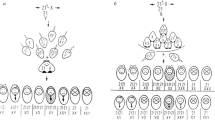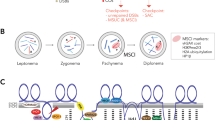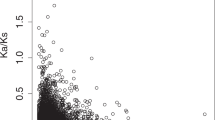Abstract
Sex-reversed (Sxr) is a dominant mutation that confers maleness on X/X Sxr mice1. Although its mode of inheritance is typically autosomal, all attempts to map Sxr to an autosomal chromosome have failed2. P. Burgoyne (personal communication) suggested that if Sxr were located at the end of the sex chromosomes, distal to a postulated obligatory cross-over in the X–Y pairing segment, it would show such an apparent autosomal pattern of inheritance. To test whether Sxr is located on one of the X chromosomes, and is perhaps therefore subject to X-chromosome inactivation, we have examined mice heterozygous for an X-autosome translocation, T(X; 16)H (ref. 3), such that the normal X chromosome postulated to carry Sxr is preferentially inactive. Independently, Singh and Jones4 have now shown by in situ hybridization that Sxr consists of a duplicated section of Y chromosome material that is indeed translocated to the distal terminus of one X chromatid during male meiosis5,6. Our results show that when the X chromosome carrying Sxr is preferentially inactivated, fertile T(X; 16)H/X Sxr females can be produced, owing to an associated inactivation of the male-determining Sxr sequences.
This is a preview of subscription content, access via your institution
Access options
Subscribe to this journal
Receive 51 print issues and online access
$199.00 per year
only $3.90 per issue
Buy this article
- Purchase on Springer Link
- Instant access to full article PDF
Prices may be subject to local taxes which are calculated during checkout
Similar content being viewed by others
References
Cattanach, B. M., Pollard, C. E. & Hawkes, S. G. Cytogenetics 10, 318–337 (1971).
Lyon, M. F., Cattanach, B. M. & Charlton, H. M. in Mechanisms of Sex Differentiation in Animals and Man (eds Austin, C. R. & Edwards, R. G.) 329–386 (Academic, New York, 1981).
Lyon, M. F., Searle, A. G., Ford, C. E. & Ohno, S. Cytogenetics 3, 306–323 (1964).
Singh, L. & Jones, K. W. Cell 28, 208–216 (1982).
Burgoyne, P. Hum. Genet. 61, 85–90 (1982).
Eicher, E. M. in Prospects for Sexing Mammalian Sperm (eds Amann, R. P. & Seidel, G. E.) (Colorado Associated University Press, Colorado, in the press).
Johnston, P. G. Genet. Res. 37, 317–322 (1981).
McMahon, A. & Monk, M. Genet. Res. (in the press).
Cattanach, B. M., Evans, E. P., Burtenshaw, M. D. & Barlow, J. Nature 300, 445–446 (1982).
Cattanach, B. M. Genet. Res. 23, 291–306 (1974).
Mystkowska, E. T. & Tarkowski, A. K. J. Embryol. exp. Morph. 20, 33–52 (1968).
Milet, R. G., Mukherjee, B. B. & Whitten, W. K. Can. J. Genet. Cytol. 14, 933–941 (1972).
Ford, C. E., Evans, E. P., Burtenshaw, M. D., Clegg, H. M., Tuffrey, M. & Barnes, R. D. Proc. R. Soc. B 190, 187–197 (1975).
McLaren, A. J. Embryol. exp. Morph. 33, 205–216 (1975).
Gearhart, J. D. & Oster-Granite, N. L. Biol. Reprod. Suppl. 24, 713–722 (1981).
Falconer, D. S. & Avery, P. J. J. Embryol. exp. Morph. 43, 195–219 (1978).
Nesbitt, M. N. Devl. Biol. 26, 252–263 (1971).
McLaren, A. J. Reprod. Fert. 61, 461–467 (1981).
Mittwoch, U. & Buehr, M. Differentiation 1, 219–224 (1973).
McLaren, A. Nature 283, 688–689 (1980).
Polani, P. Hum. Genet. 60, 207–211 (1982).
McLaren, A. & Monk, M. J. Reprod. Fert. 63, 533–537 (1981).
Gartler, S. M., Rivest, M. & Cole, R. E. Cytogenet. & Cell Genet. 28, 203–207 (1980).
Kratzer, P. G. & Chapman, V. M. Proc. natn. Acad. Sci. U.S.A. 78, 3093–3097 (1981).
Evans, E. P., Ford, C. E. & Lyon, M. F. Nature 267, 430–431 (1977).
Gordon, J. J. exp. Zool. 367–374 (1976).
Schüpbach, T. Devl. Biol. 89, 117–127 (1982).
Bücher, T., Bender, W., Fundele, R., Hofner, H. & Linke, I. FEBS Lett. 115, 319–324 (1981).
Author information
Authors and Affiliations
Rights and permissions
About this article
Cite this article
McLaren, A., Monk, M. Fertile females produced by inactivation of an X chromosome of ‘sex-reversed’ mice. Nature 300, 446–448 (1982). https://doi.org/10.1038/300446a0
Received:
Accepted:
Issue Date:
DOI: https://doi.org/10.1038/300446a0
This article is cited by
-
Recombination between the mouse Y chromosome short arm and an additional Y short arm-derived chromosomal segment attached distal to the X chromosome PAR
Chromosoma (2016)
-
Anne McLaren 1927–2007
Nature Genetics (2007)
-
The role of human and mouse Y chromosome genes in male infertility
Journal of Endocrinological Investigation (2000)
-
Deletion of Y chromosome sequences located outside the testis determining region can cause XY female sex reversal
Nature Genetics (1993)
-
The X chromosome in development in mouse and man
Journal of Inherited Metabolic Disease (1992)
Comments
By submitting a comment you agree to abide by our Terms and Community Guidelines. If you find something abusive or that does not comply with our terms or guidelines please flag it as inappropriate.



